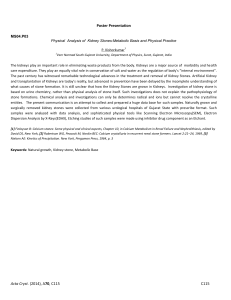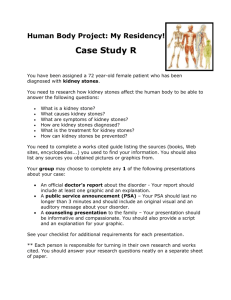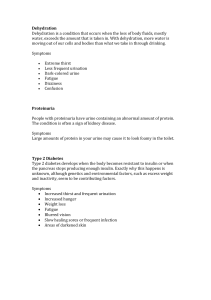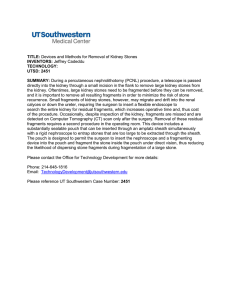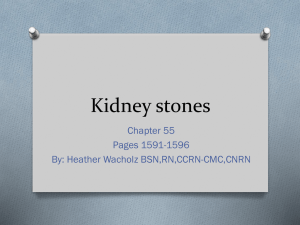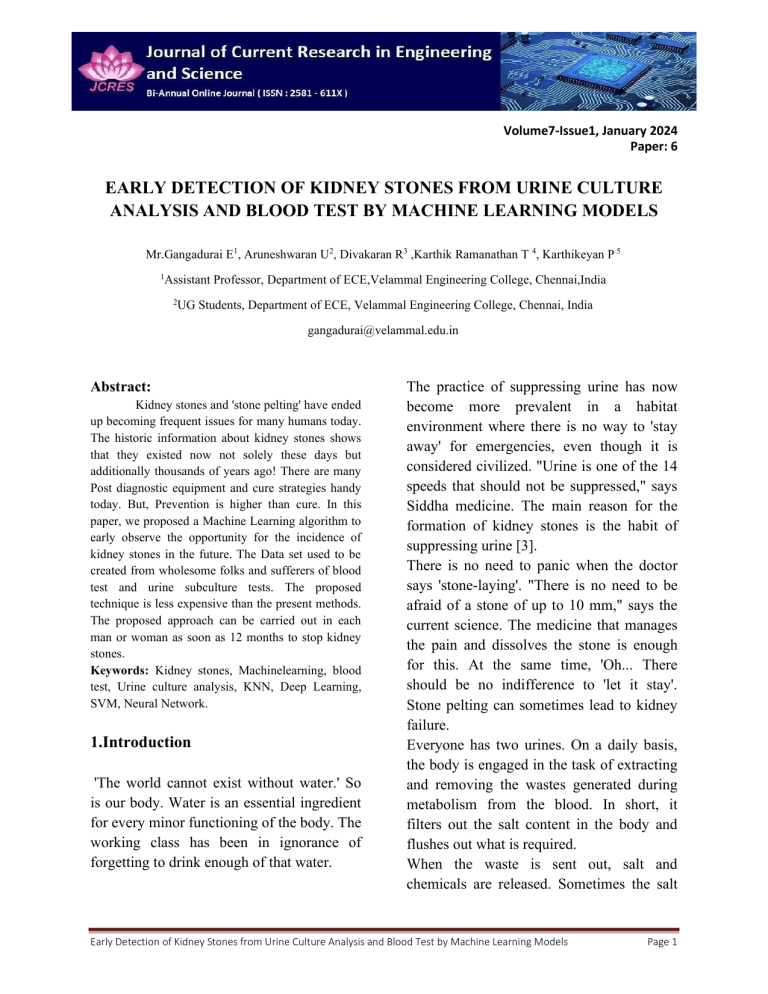
Volume7-Issue1, January 2024 Paper: 6 EARLY DETECTION OF KIDNEY STONES FROM URINE CULTURE ANALYSIS AND BLOOD TEST BY MACHINE LEARNING MODELS Mr.Gangadurai E1, Aruneshwaran U2, Divakaran R3 ,Karthik Ramanathan T 4, Karthikeyan P 5 1 Assistant Professor, Department of ECE,Velammal Engineering College, Chennai,India 2 UG Students, Department of ECE, Velammal Engineering College, Chennai, India gangadurai@velammal.edu.in Abstract: Kidney stones and 'stone pelting' have ended up becoming frequent issues for many humans today. The historic information about kidney stones shows that they existed now not solely these days but additionally thousands of years ago! There are many Post diagnostic equipment and cure strategies handy today. But, Prevention is higher than cure. In this paper, we proposed a Machine Learning algorithm to early observe the opportunity for the incidence of kidney stones in the future. The Data set used to be created from wholesome folks and sufferers of blood test and urine subculture tests. The proposed technique is less expensive than the present methods. The proposed approach can be carried out in each man or woman as soon as 12 months to stop kidney stones. Keywords: Kidney stones, Machinelearning, blood test, Urine culture analysis, KNN, Deep Learning, SVM, Neural Network. 1.Introduction 'The world cannot exist without water.' So is our body. Water is an essential ingredient for every minor functioning of the body. The working class has been in ignorance of forgetting to drink enough of that water. The practice of suppressing urine has now become more prevalent in a habitat environment where there is no way to 'stay away' for emergencies, even though it is considered civilized. "Urine is one of the 14 speeds that should not be suppressed," says Siddha medicine. The main reason for the formation of kidney stones is the habit of suppressing urine [3]. There is no need to panic when the doctor says 'stone-laying'. "There is no need to be afraid of a stone of up to 10 mm," says the current science. The medicine that manages the pain and dissolves the stone is enough for this. At the same time, 'Oh... There should be no indifference to 'let it stay'. Stone pelting can sometimes lead to kidney failure. Everyone has two urines. On a daily basis, the body is engaged in the task of extracting and removing the wastes generated during metabolism from the blood. In short, it filters out the salt content in the body and flushes out what is required. When the waste is sent out, salt and chemicals are released. Sometimes the salt Early Detection of Kidney Stones from Urine Culture Analysis and Blood Test by Machine Learning Models Page 1 Volume7-Issue1, January 2024 Paper: 6 in the waste becomes small particles and accumulates in the kidneys. Then it gradually becomes a stone. Some particles turn into a stone and cause blockage in the organ, affecting the functioning of the urinary tract. The uninfected stone will be small in size. It will be less than 5mm in size. For some people, tamarind seeds can grow up to 5.8 mm in size. Large stones are those that are more than 1 cm long. The intensity of the pain depends on the size of the stone. For some people, the stone is very small in size. But the intensity of the pain increases. Some people will have a big stone. But the pain doesn't hurt much. The problem begins when the stone in the urinary bladder moves through the urethra and goes out. It prevents urine from passing through. That's when it causes pain. The kidneys contain various chemical salts. For example, salts such as calcium oxalate, uric acid, calcium phosphate, etc., are high, which turn into particles [9]. Kidney stones are very painful. It is better to prevent them than to wait for them to happen. Kidney stone natural remedies are a great way to prevent kidney stones. Kidney stones can be painful and scary, but they can be prevented with the right diet and supplements. The kidneys build up calcium, which eventually hardens into small crystals along with other minerals like uric acid or phosphate and forms some kind of stone in your urinary tract [8]. A blood test will be done when you consult a doctor based on the symptoms. Then they look at the amount of calcium and uric acid present in the white cells that make up the kidney stones. Depending on this, a urine test will be done. The doctor will treat you with the waste that comes out of it. 2.Existing System Up to 90% of the stones can be identified by an ultrasound scan test when the symptoms are severe. If the stones are in the urinary tract, a CT scan will be done to determine the nature of the stones and treat them. Up to 90% of the stones can be identified by an ultrasound scan test when the symptoms are severe. If the stones are in the urinary tract, a CT scan will be done to determine the nature of the stones and treat them. 3.Proposed System In this paper we proposed a deep learning algorithm to detect the possibility of occurrences of kidney stones in the near future from urine and blood test data. The data set was created by collecting the test samples of data from healthy persons and diseased persons. Machine learning algorithm will use this data for prediction. 4.Testing Methods If doctor suspects that a patient have a kidney stone, he suggeststo have diagnostic tests and procedures, such as: i)Blood testing- Blood is a very important component used to analyze the health of any human. Presence of high uric acid,calcium Early Detection of Kidney Stones from Urine Culture Analysis and Blood Test by Machine Learning Models Page 2 Volume7-Issue1, January 2024 Paper: 6 and other components in blood indicate unhealthy kidney function.The level of certain minerals in your blood, which can cause kidney stones, can be determined by the blood test.ii)Urine testing-Urine is one of the very important biological waste generated from the kidney. we can find out if your urine contains a lot of minerals that cause kidney stones by having it tested. Presence of malicious substances like calcium, Uric acid, and phosphate etc.Various kinds of kidney stones: Struvite, calcium, and cystite stones are the four types of stones [4]. Table 1 Standard values of blood and urine content 6.Block Diagram In Tamilnadu, the dataset was collected over six months. It has 500 rows and 28 features like sugar, pedal edema, red blood cells, and other things. This csv file contains 6 input attributes and a single target column with binary values. conductivity of urinecond, concentration of urea in urine- urea, concentration of calcium in urine- calc, specific gravity of urine- gravity, ph of urine- ph, osmolarity of urine- osmo[7]. The objective is to categorize whether or not a patient has kidney stones. The dataset has been cleaned, with changes like mapping the text to numbers and other things. We've done some exploratory data analysis (EDA), divided the dataset into training and testing, and put the models on those datasets. Exploratory data analysis will be carried out to visualize the data in patterns after preprocessing and pruning work on the collected data. Next, the data is applied to train the built machine learning model(KNN, SVM, Neural Network) and corresponding machine learning performance parameters values are recorded [5]. After testing the machine learning model for desired performance, the model is now ready to solve our real-time problems. Figure-1 Block Diagram of a machine learning Model Early Detection of Kidney Stones from Urine Culture Analysis and Blood Test by Machine Learning Models Page 3 Volume7-Issue1, January 2024 Paper: 6 𝟏)𝑪𝑳𝑨𝑺𝑺𝑰𝑭𝑰𝑪𝑨𝑻𝑰𝑶𝑵 𝑨𝑪𝑪𝑼𝑹𝑨𝑪𝒀 𝑻𝑷 + 𝑻𝑵 = −− 𝑻𝑷 + 𝑻𝑵 + 𝑭𝑷 + 𝑭𝑵 − − − − − − − − − (1) 𝟐)𝑷𝑹𝑬𝑪𝑰𝑺𝑰𝑶𝑵 = 𝑻𝑷 − − − − − −(2) 𝑻𝑷 + 𝑭𝑷 Where TP- True Positive TN-True Negative FP-False Positive FN- False Negative 7.Simulated Results Figure-3 Reference parameters Vs concentration. Figure 2-Histogram of gravity,ph,osmo, cond,urea,calc. Figure-4 Gravity Vs count. Early Detection of Kidney Stones from Urine Culture Analysis and Blood Test by Machine Learning Models Page 4 Volume7-Issue1, January 2024 Paper: 6 Figure-3 Calcium Vs conunt. Figure-5Pair Plots Inferencefrom theplot 5 (i)There is a strong positive correlation between Osmo and cond and a higher calcium concentration in kidney stone patients. (ii) calc and Osmo have a significant positive correlation. (iii)There are serious areas of strength for a connection among's osmo and urea. 8.Conclusion and Future work The proposed machine learning model performs well compared with other existing post-diagnosing methods. We can easily detect the possibilities of the occurrence of kidney stones earlier by proper tuning the machine learning Early Detection of Kidney Stones from Urine Culture Analysis and Blood Test by Machine Learning Models Page 5 algorithm and using prompt data set. Presently, the Test Accuracy is 86% and train Accuracy is 89%, but in future test and train accuracy can be improved by increasing the dataset with more parameters and choosing machine-learning models. References 1.Williams, J.C., Gambaro, G., Rodgers, A. et al. Urine and stone analysis for the investigation of the renal stone former: a consensus conference. Urolithiasis 49, 1–16 (2021). https://doi.org/10.1007/s00240-020-01217-3 2. Khan SR, Pearle MS, Robertson WG, Gambaro G, Canales BK, Doizi S, Traxer O, Tiselius HG. Kidney stones. Nat Rev Dis Primers. 2016 Feb 25;2:16008. doi: 10.1038/nrdp.2016.8. PMID: 27188687; PMCID: PMC5685519. 3. Thongprayoon C, Krambeck AE, Rule AD. Determining the true burden of kidney stone disease. Nat Rev Nephrol. 2020;16(12):736– 746. 2. Sorokin I, Mamoulakis C, Miyazawa K, Rodgers A, Talati J, Lotan Y. Epidemiology of stone disease across the world. World J Urol. 2017;35(9):1301–1320. 4. Wang W, Fan J, Huang G, Li J, Zhu X, Tian Y, et al. Prevalence of kidney stones in mainland China: A systematic review. Sci Rep. 2017;7:41630. 5. Chen D, Jiang C, Liang X, Zhong F, Huang J, Lin Y, et al. Early and rapid prediction of postoperative infections following percutaneous nephrolithotomy in patients with complex kidney stones. BJU Int. 2019;123(6):1041–1047. 6.https://medlineplus.gov/lab-tests/kidney-stoneanalysis/ 7.https://www.kaggle.com/datasets/vuppalaadith yasairam/kidney-stone-prediction-based-onurine-analysis. Volume7-Issue1, January 2024 Paper: 6 8. Alelign T, Petros B. Kidney Stone Disease: An Update on Current Concepts. Adv Urol. 2018 Feb 4;2018:3068365. doi: 10.1155/2018/3068365. PMID: 29515627; PMCID: PMC5817324. 9. Bird VY, Khan SR. How do stones form? Is unification of theories on stone formation possible? Arch Esp Urol. 2017 Jan;70(1):12-27. PMID: 28221139; PMCID: PMC5683182. 10.Abraham A, Kavoussi NL, Sui W, Bejan C, Capra JA, Hsi R. Machine Learning Prediction of Kidney Stone Composition Using Electronic Health Record-Derived Features. J Endourol. 2022 Feb;36(2):243-250. doi: 10.1089/end.2021.0211. PMID: 34314237; PMCID: PMC8861926. 11. Khanijou V, Zafari N, Coughlan MT, MacIsaac RJ, Ekinci EI. Review of potential biomarkers of inflammation and kidney injury in diabetic kidney disease. Diabetes Metab Res Rev. 2022;38(6):e3556. doi:10.1002/dmrr.3556 12. Chen Y, Shen X, Li G, Yue S, Liang C, Hao Z. Association between aldehyde exposure and kidney stones in adults. Front Public Health. 2022;10:978338. Published 2022 Oct 10. doi:10.3389/fpubh.2022.978338 13. Sassanarakkit S, Hadpech S, Thongboonkerd V. Theranostic roles of machine learning in clinical management of kidney stone disease. ComputStructBiotechnol J. 2022;21:260-266. Published 2022 Dec 5. doi:10.1016/j.csbj.2022.12.004 14. Khalid H, Khan A, Zahid Khan M, Mehmood G, Shuaib Qureshi M. Machine Learning Hybrid Model for the Prediction of Chronic Kidney Disease. ComputIntellNeurosci. 2023;2023:9266889. Published 2023 Mar 14. doi:10.1155/2023/9266889 Early Detection of Kidney Stones from Urine Culture Analysis and Blood Test by Machine Learning Models Page 6
